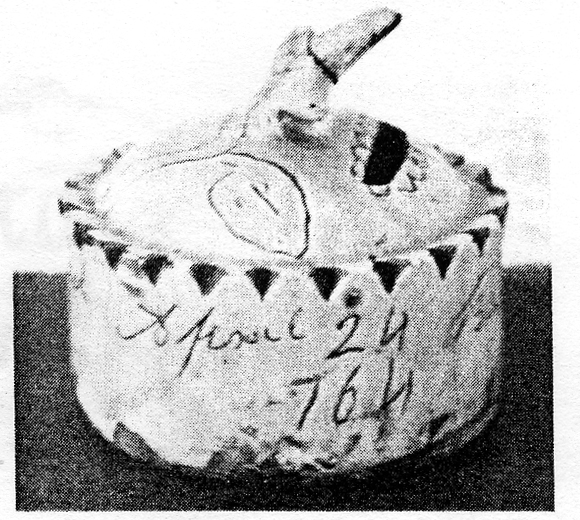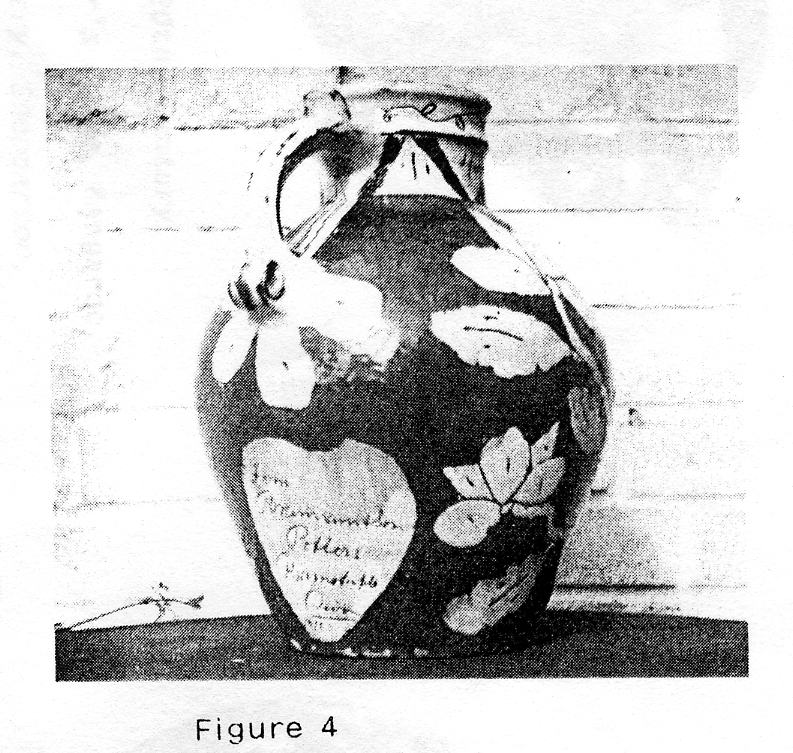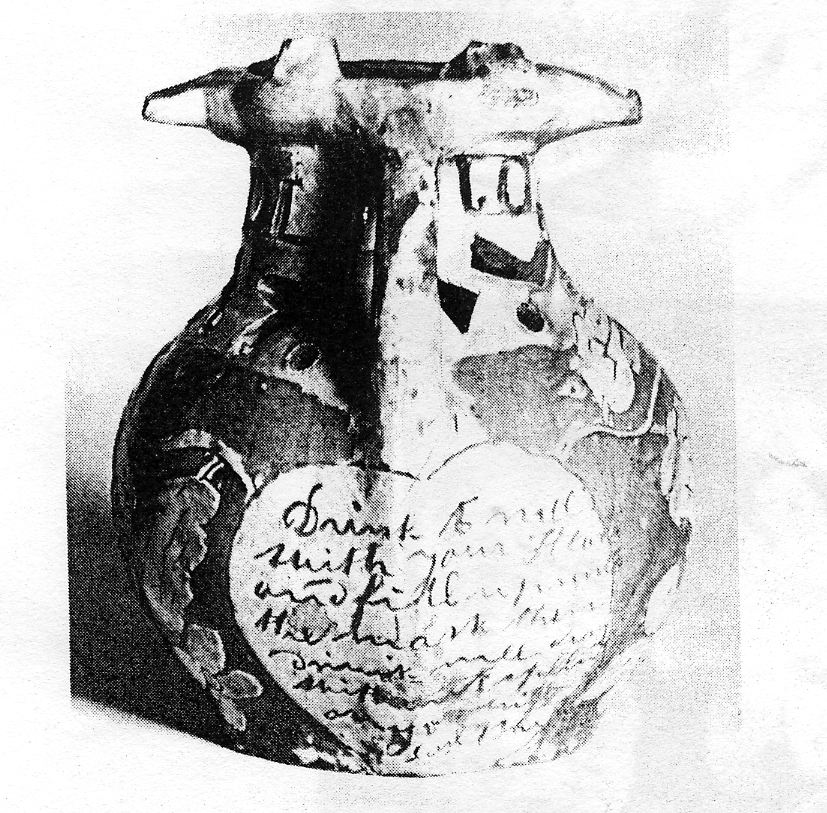by Patrick Brannam
There is in the British Museum a North Devon ware jug (Reg. No.1920,3-18,4) - (figure 1) which was part of the Boynton bequest to the Museum in 1920. It had previously been included in the Exhibition of Early English Earthenware at the Burlington Fine Arts Club in 1914. It was then described in the catalogue as
| Jug with oval body, high neck and lip spout; handle with rolled end and thumbpiece. Reddish buff ware coated with white slip; graffiato ornament, the ground of the design cut away. In front a conventional sun; floral designs at the side; chevron pattern and scroll band on the neck. Under the handles a panel inscribed : Mrs E.F.Brewer. W.E.Bank for kindness to a pore man James Brannan Nov. 29 1691. It Is 7.5 inches high and 6.5 inches diameter including the handle. |
Charles William Brannam (1882-1964), elder son of Charles Hubert Brannam the renowned Art Potter, in a paper to the Barnstaple Rotary Club' referred to examples of pottery produced in Barnstaple (in the 17/18th centuries) being in the British Museum and noted the James Brannam (sic) jug. The late John Robert (Peter) Brannam, grandson of C H Brannam, describes in his history of the firm of C H Brannam Ltd, A Family Business2 the setting up of the predecessor firm by Thomas Brannam his own great grandfather. He then refers to a minor mystery over a piece in the British Museum dated 1691 and inscribed "James Brannam" with other lettering. He goes on to say that
| there is no evidence to connect it with our own Brannams, but maybe this was an ancestor already potting in the Bideford area at that date; if so the line is indeed a long one. |
Alison Grant in her North Devon Pottery: the Seventeenth Century, refers to some nineteenth century North Devon jugs of rather poor quality at the British Museum one of which was said to bear the faked date 1691.3 See also this link

|  |
| Figure 1: North Devon ware jug (Reg. No.1920,3-18,4). | Figure 2. |
When was the Jug made?
Mrs Snetzler of the North Devon Athenaeum believes4 the inscription on the British Museum jug to refer to Mrs Elizabeth Fortescue Brewer/West of England Bank.
Mrs Brewer's husband was William Henry Brewer and in 1871 they were living at the West of England Bank in Boutport Street, Barnstaple where William was a Bank Clerk. By 1881 they had moved to Honiton. The bank, otherwise known as the West of England and South Wales District Bank, opened in Barnstaple in 1845 and closed in 1878. The Brewers were probably married about 1867.
The signature on the Jug also appears on several jugs and documents within our branch of the family and is that of James Brannan/m (1803-1876), my great great grandfather.
A jug much like the British Museum jug is shown in figure 2. Two of these other large jugs are dated 1871 and I conclude that the British Museum jug was made about that time. ,
Fake Date?
Why should a jug given to Mrs Brewer at the West of England Bank for kindness be given a fake date? Fake dating was not unknown. P C D Brears5 describes as of particular interest the Old English two handled mugs made by C H Brannam in the 1880s. One of these inscribed "Words are easy / Like the wind / Faithful friends / Are hard to find / 1776" is described as presented to the North Devon Athenaeum by the maker in 1883.
| Figure 3: The money box (figure 3) also made by James Brannan bears the Inscription "Be faithful and true to the Lord April 24 164 ("1", not "7", the cross piece apparently being a slip flaw). | 
|
The Jug in figure 2 has, after July 14, the figures 168 where the year might be expected. On the British Museum Jug, after Nov. 27 the figure 169 of 1691 are clearly incised. The final "1" might be a slip or glazing flaw. The jugs were made around 1871 when James Brannan was about 68 years old. Was he still working, if so for whom? If not, was it a pastime, if so whose kiln did he have access to? Are what could be 164, 168 and 169 which are also in month order on the pots part of years or pot numbers? I do not know. Perhaps others have answers.
There is another jug similar to that in the British Museum-- with a crude sailing ship on the front, rather than the conventional sun. From the decoration I suspect it was also made about 1871. This jug bears the Inscription "James Brannan Born February 14 182". This could be 1802, but it is probably a year out as he was christened on 20 February 1803 and it was then more usual for christenings to take place soon after birth.
James Brannan - no evidence to connect with Peter Brannam's forebears?
James Howard Brannan/m (the spelling varies), was the third child of shoemaker or cordwainer Abraham and Mary (nee Backway) Brannan and was christened in Bideford on 20 February 1803. Other than some possible earlier pots (see below) I know nothing of him until, as widower and sojourner, he remarried in Barristaple on 1st January 1829. His wife was Elizabeth Rice from a family of potters. In 1841 they were living in Castle Lane, Barnstaple, close to Rendell's North Walk Pottery and the census shows him as a potter. Their address in 1845 was Potter's Lane, Barnstaple. For whom he was working at that time I do not know.
Thomas Backway Brannan, his brother, was the sixth child of Abraham and Mary Brannan (cf. third child in ref. 2) and was born in Bideford in 1815. He took over Rendell's North Walk Pottery in 1848 after having worked for Thomas Rendell for some years.6 & 7. About this time his elder brother James appears to have moved back to Bideford (James's daughter Sarah was born there in 1847). I speculate that James may have worked for Rendells but he did not want to work for his younger brother when he took over the pottery.
However, by the 1851 census, the year of the Great Exhibition, James once more described as a potter was again living in Barnstaple in Palges Lane close to Potter's Lane. Thomas was now described as a master potter employing five men and three boys but whether James was amongst them I do not know. This was the year that Thomas, described in the Exhibition catalogue as an inventor8 received one of the numbered bronze medals, given to all exhibitors, for his display of - Oven, Syphon Trap an Improved invention for water closets, Gothic crease upon an improved plan (sic) and earthenware Jugs, pitchers and mllkpan all made of Devonshire clay. I .have failed to trace any further description or photograph of this exhibit. In 1853 Thomas Brannam bought the Litchdon pottery in Barnstaple and in 1854 James Brannam was living in Litchdon but again whether he worked for Thomas I do not know. James is shown in the 1861 and 1871 censuses as a potter living in Maiden Street and Hardaway Head, both not far from Litchdon. He died "a pore man" in Hardaway Head in 1876. Perhaps someone is able to throw some light on the working relationship of these two brothers.
Charles Hubert Brannam who was the son of Thomas, nephew of James and grandfather of Peter Brannam, was born in January 1855.
Figure 4 shows a jug similar in style to those of James in figures 1 and 2. It is inscribed from Brannam and Son Potters Barnstaple 1871 (Thomas and 16 year old Charles Hubert) but the script is not that of the 68 years old James. Whose might it be? When did Thomas take his son into the business? Are there in existence any pots signed or inscribed by Thomas or, at this early stage, by Charles? The 1871 census shows Thomas as a master potter employing twelve men and two boys at Litchdon Street.

|
| Figure 4 |
Possible Earlier James Brannan Pots
Item 65 of the Glaisher Collection at the Fitzwilliam Museum, is a puzzle Jug (figure 5) which came from the Charbonnier Collection, Lynton 1912. As well as the inscription below the handle the neck is pierced with perforations of the name JOHN ARNOLD. There is a row of geometrical piercings with the date Nov. 13 1827 among them. It appears to match other James Brannan jugs in style and the inscription appears to be in James Brannan's hand.

|
| Figure 5 |
The A. Brannan could be either the father or the brother of James.
Perhaps there is a clue to be followed as to where James Brannan was working about that time in that he married Elizabeth Rice (spinster) in 1829. A Samuel Fishley, potter son of William Fishley, potter, had also married an Elizabeth Rice at Instow, near Fremington In 1815, but whether the two Elizabeths were related I do not know.
Conclusions
There are still some unanswered questions about the British Museum jug. James Brannan/m was not an ancestor of C H Brannam, potting in the Bideford area about 1691, but was his uncle. There remains a mystery about the working relationship between the two brothers, James and Thomas Brannam, and probably much more to find out about the working lives of both of them.